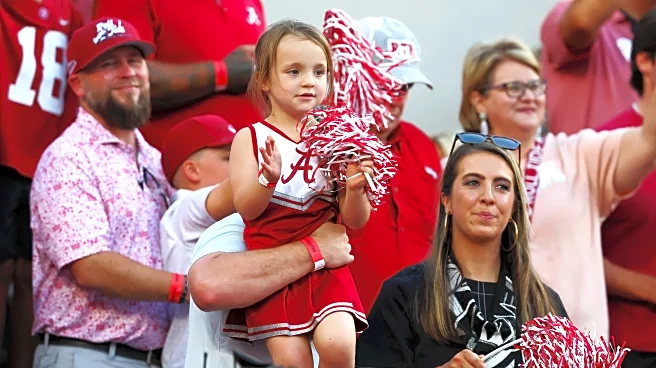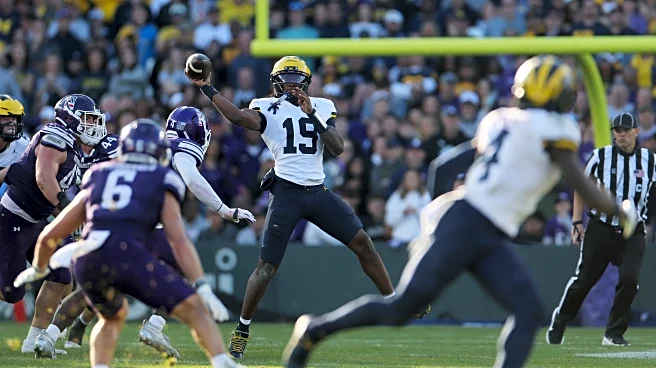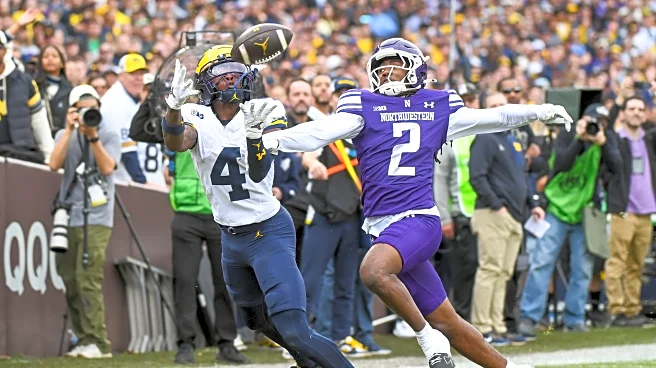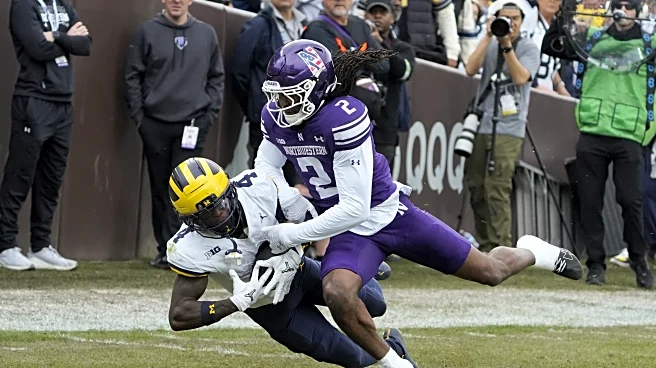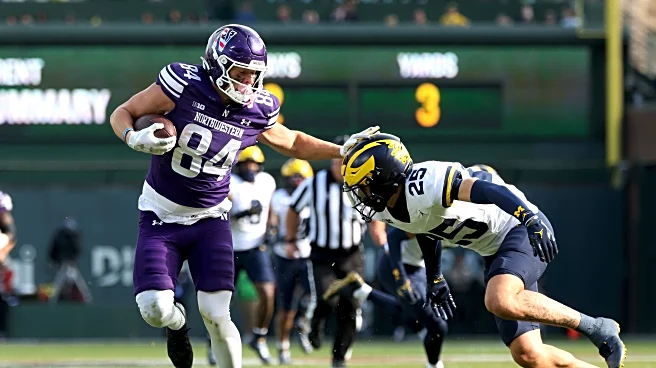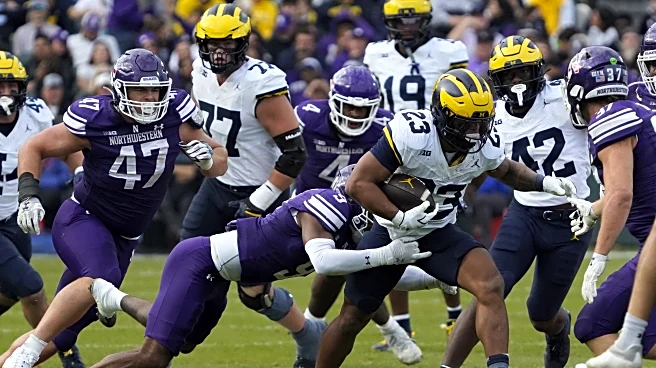It was the best of Bryce; it was the worst of Bryce.
On Saturday at Wrigley Field, quarterback Bryce Underwood strung together one of the most “freshman” performances any viewer has probably ever seen.
Equal parts brilliant and frustrating, the young gunslinger had it all on display against Northwestern.
Underwood was surgical to start the game. He connected on 10 of his first 11 passes for 139 yards and looked like a third-year starter with complete command of the offense. But for the majority of the fourth quarter, he had the control of a seventh grader joy-riding around in his dad’s Ford Bronco. Responsible for three consecutive drives ending in turnovers, this juxtaposition of play is rarely seen in the same game. Unless you’re a Texas A&M fan. However, he may have also grown up right before our eyes with the best play of his young career to steal victory from the jaws of defeat.
For this week’s film study, let’s take a look at four of the five turnovers from Saturday, examine why they happened and why they’re easily correctable (the punt return fumble need never be discussed again and Semaj Morgan need never be seen wearing a Michigan uniform again). And to close on a positive note, let’s take a look at the best play of Underwood’s career.
Let’s check the tape!
13-personnel Double Bluff Reverse (Fumble)
The first turnover in the game actually came in the second quarter. Michigan had Northwestern on its heels and dialed up a reverse. Contrary to analyst Joel Klatt, who was solid on Saturday, I loved the timing of this call. When the run game is working, it’s the perfect time to call misdirection because you are anticipating the defense to overreact to the run action. Unfortunately, Northwestern had other plans.
The Wolverines come out in 13-personnel and want to sell the double bluff on the edge. The same blocking scheme they have been utilizing increasingly more since Michigan State and a reverse play they have had on the play sheet since at least 2021. Here’s what it looks like successfully:

The tight ends coming over are going to bluff the defensive end and both go outside. The first man through is going to kick out whatever shows first — linebacker or safety — and the second man is the escort for whatever is left. Pre-snap, Michigan gets the look it wants; post-snap, a run blitz blows everything to smithereens.

Northwestern sends both edges on wide rushes, blitzes the MIKE linebacker, who is replaced by a safety, and widens the WILL for contain. Typically, the edge is responsible for contain and Michigan wants to put him in conflict to make a decision, similar to the hesitation the Wolverines got from this bluff play against Michigan State.

However, Northwestern acutely removes decision-making from the edge’s assignment and allows him to just attack the quarterback full tilt with help behind him. Now, if Michigan is running a traditional split zone, this could have been exploited. But with the reverse action, it was the worst possible outcome. In the future, look for Michigan to come back to the reverse, but out of a similar (safer) design with the center pulling like the Wolverines used against Central Michigan.

11-Personnel Hoss Concept (Interception)
Facing a 3rd-and-9 early in the fourth quarter, offensive coordinator Chip Lindsey draws up a Hoss concept. The three receivers split to the bottom — Semaj Morgan (WHY?), Andrew Marsh and Deakon Tonielli (closest to the line of scrimmage) — are going to run a Comeback, Go, and Stick route accordingly. Backside, Donaven McCulley is going to run a 10-12 yard out.

Northwestern counters with a unique zone blitz. Pre-snap, the Wildcats have six across the line of scrimmage, but are going to drop the linebacker and loop the safety from the far edge as the sixth rusher. The offensive line and running back Jordan Marshall actually do an outstanding job picking up this pressure and giving Underwood time to throw. Behind the pressure, Northwestern runs a Cover 3 variation with three defenders deep and only two underneath. Underwood thinks he has man-to-man and never sees the nickel settle underneath.

If he were able to process this faster, Underwood would have thrown the Go ball to his alert receiver, Marsh. But in Underwood’s defense, this is a creative, Wink Martindale-esque pressure, and one Northwestern hasn’t likely called all season. The fault lies with the quarterback, but he will file this lesson away and exploit it later.
11-Personnel Zone Read RPO X-Slant (Interception)
This is Michigan’s bread-and-butter RPO. The Wolverines had called it a handful of times already in this game and Underwood had carved up the defense with accurate reads. In fact, it could be argued this is Underwood’s best play. But in this instance, he reverted back to youthful tendencies and pre-determined his read.
Before the snap, McCulley is split to the top of the formation with Morgan in the slot (again, WHY?). Marsh is split to the bottom and tight end Marlin Klein is the H-back. Morgan goes in motion and carries the nickel with him. At this point, Underwood knows he’s going to throw it to McCulley and never even looks at the safety.

At the snap, Underwood is anticipating the safety to collapse in run support and never looks his way. The read here is to give, even if it results in no gain — Michigan would go to 3rd-and-4 and fight another day. But without seeing the safety, Underwood stares down McCulley and rips a ball that is plucked from the air by the unseen defender. Even if the ball isn’t picked by the underneath safety, the backside safety is cheating over to make a play on the ball.
12-Personnel Zone-Read Wedge (Fumble)
A wedge play is simple. Designed for short-yardage scenarios, everyone on the line of scrimmage down-blocks to the inside. The goal is to gain one or two yards and keep the chains moving. Nothing fancy, but highly effective. Most of the time.
The play is run out of the pistol formation to give Underwood a chance to read the edge defender to decide whether to give or keep the ball. At the snap, Underwood rides new running back Bryson Kuzdzal and waits until the last second to try to hand him the ball. Unfortunately, Underwood’s ball placement is too high on his running back, missing the exchange point and fumbling the ball.

Long reads are a death sentence for short yardage. Underwood either needs to give this ball to his running back immediately so Kuzdzal can build up momentum and Underwood can then still hold the backside edge with a fake pull, or pull this ball quickly if he sees the edge screaming downhill and attack the perimeter. By holding the read longer, everything falls apart. It also doesn’t help when the center of this wedge misses everyone and ends up on the ground five yards in front of the play. Sigh.
At this point, everything had fallen apart. Underwood had relapsed into perpetual indecision and was making rookie mistakes. Jordan Marshall was out for the game, 2024 All-American kicker Dom Zvada is kicking worse than fan participants on College GameDay, five turnovers seemed insurmountable. This was it. The season was lost.
But then it wasn’t.
12-Personnel Delayed Hank Concept
On 3rd-and-10 with two minutes to go and everything on the line, Underwood proved why he is special. Michigan runs a variation of a Hank concept with Marsh (top of the formation) running a (20-yard) corner, and Klein (H-back) selling a block before releasing into the flat. Tight end Zack Marshall (slot to the bottom) and X-receiver McCulley both run posts from the back side.
Northwestern rushes three and gets pressure, positions a spy to mirror the quarterback, and drops seven into pure coverage. The Wildcats should win this rep and the game. They have done everything right. But they don’t have Underwood and Marsh.
At the snap, Underwood settles into the pocket until he feels his right tackle drowning. He doesn’t glance at the rush or panic. He calmly steps up into the pocket, keeps his eyes downfield and escapes out to his left. With the spy triggering on his movement, he again does not panic, but calmly delivers a layered pass across his body while he’s being hit. The pass goes over a linebacker and a safety and to an outstretched Marsh on the sideline. Michigan moves the chains and sets up the game-winning field goal.

This is the best play of Underwood’s career. It was like everything preceding this in the fourth quarter never happened. Not to mention, this one play underscores growth in several areas. Underwood feels the pressure instead of looking at it. Escapes out of the pocket but kept his eyes down the field. Takes the contact from the rusher instead of bracing for it. And layers a touch pass instead of a fast ball.
Earlier in the season, Underwood tries to tuck and run this ball for minimal gain. But now, despite nothing going his way this quarter and the fate of the game and season hanging in the balance, he stays cooler than the other side of the pillow. In one single throw, Underwood showed growth and maturity that is missing from many of the top quarterbacks in the country.
He has a lot to clean up (A LOT), but with two outs in the bottom of the ninth following multiple strikeouts at Wrigley Field, Underwood hit one out of the park.



